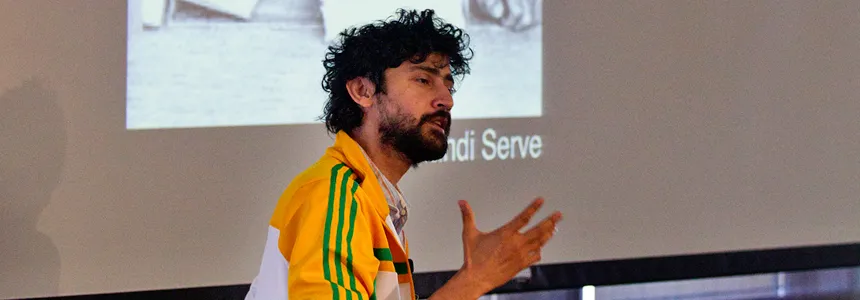
Inside Stanford Medicine, January 24th, 2014 - by Kris Newby
Manu Prakash, PhD, took a photo late last year while visiting the Tororo District in eastern Uganda: It shows children sitting on the grave of one of two siblings buried side by side.
Both were likely casualties of malaria or some other infectious disease, said Prakash, an assistant professor of bioengineering, a Bio-X affiliate and a Clark Center faculty member. The photo serves as a tragic reminder of the toll in Africa of such diseases, which Prakash is fighting through his lab's efforts to develop low-cost diagnostics. He was most recently in Africa last November to evaluate some of his inventions.
"Being in the field gives meaning to working in global health," Prakash said. "It teaches you empathy, a driving force so strong that it transforms ideas into actions."

Photo by Dr. Manu Prakash: Children in Uganda sit at the
graves of two of their siblings buried side by side. Both
were likely victims of infectious disease.
His latest invention is an electromagnetic patch able to noninvasively detect parasitic worms. To help test it, Prakash and co-investigator Judy Sakanari, PhD, a research pathologist at the UC-San Francisco, received a $100,000 Grand Challenges Explorations award from the Gates Foundation.
The first prototypes will be used to detect the worm that causes onchocerciasis, or "river blindness," which afflicts approximately 37 million people in Africa, Yemen and Central and South America. Transmitted through repeated bites of blackflies, it is a major cause of preventable blindness.
Current diagnostic methods require the use of expensive ultrasound equipment to determine whether parasitic worms are alive under the skin or inside lymph nodes. Prakash's more frugal design consists of a Band-Aid-sized patch embedded with a sensor to detect minute electrical changes when worms wiggle under the skin or form calcified cysts. He expects that the final device will cost less than $10 and will be easier to use in rural settings.
"Being in the field gives meaning to working in global health," Prakash said. "It teaches you empathy, a driving force so strong that it transforms ideas into actions."
On the same trip, Prakash and Jim Cybulski, a Stanford PhD student in mechanical engineering, were working to clinically evaluate Foldscope, an inexpensive microscope made of folded paper that is being mass-produced and used for diagnosing diseases like malaria, schistosomiasis, African sleeping sickness, tuberculosis and various filarial diseases. The Foldscope project is funded by Spectrum, the Stanford Center for Clinical and Translational Research and Education, and C-IDEA, Stanford's Consortium for Innovation, Design, Evaluation and Action. (In addition, Cybulski recently was awarded a Global Health Equity Scholars Fellowship, funded by National Institutes of Health, for field testing the device.)
The magnitude of the malaria problem in Uganda, which has one of the highest rates of infected mosquitoes in the world, became crystal clear during their trip.
"There was one hut where we trapped 400 mosquitoes in one night," Prakash said. "And some public health centers that we visited had almost 100 malaria cases per day, with mothers of large families bringing in at least one child a week for testing."
The Grand Challenges Exploration initiative, sponsored by the Bill & Melinda Gates Foundation, is designed to fund innovative ideas to address persistent global health and development problems. Winners in this round had to demonstrate, in just two pages, a creative idea critical to global health, such as next-generation condoms, ways to help female farmers in the developing world and new interventions for neglected tropical diseases. Prakash's idea for the electromagnetic patch was chosen from among 2,700 proposals that spanned 14 countries.
Applications for the next round of exploration grants will open in March. More information is available at http://www.gcgh.org/explorations/Pages/GrantsAwarded.aspx.

